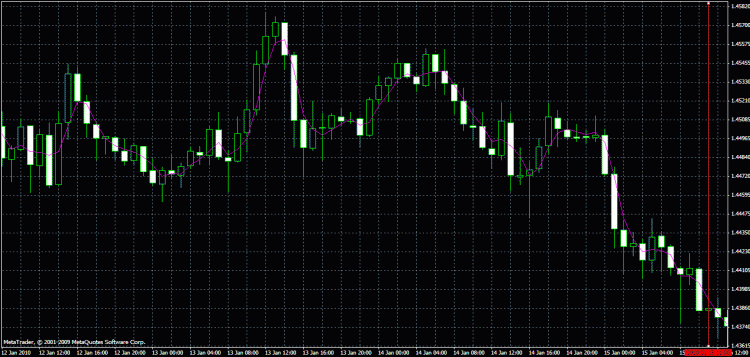Let me explain briefly (I'm sorry, I'll leave out the details)
We have a recursive filter defined by difference equation, similar to EMA, with parameter alpha. Since there is only one parameter, we will adapt it. Idea: let it check if the market behavior corresponds to a certain a priori set model at any given moment of time. A certain value, which we will call "adequacy ratio" (AR) for the sake of certainty, is introduced and calculated. Let it vary from 0 to 1, where 1 corresponds to complete "correspondence" and 0 to complete "nonconformity". Further reasoning is as follows: if KA is close to one, then the market may not be monitored too "closely", as it develops predictably within the framework of our model. If, on the contrary, the KA is close to 0, we believe that the predictability of market behavior has declined and the price should be tracked "more carefully". We conclude that the parameter alpha should be a monotonic function of CA. Let's select the dependence (e.g. linear) and go ahead.
As can be seen from the figure, it is quite good to track the trends (though always differently) and nail the unnecessary fluctuations in the flat. I would like to hear someone's opinion, based on personal experience, as to how successful this is.
Не вижу ничего особенного. Может я что-то не заметил, тогда уточните что вы хотели получить. Например машка на 6 по средним ценам даст почти такой же результат (не проверял) но мне кажется. :)
Yes, you should have done it right away.
Here: the blue one is the yamashka(6) in the middle

I don't understand it yet either, but if you're familiar with engineering, you might know the feeling - somewhere around the heel, there's a distinct feeling that there's something here that you can't get hold of... That's why I'm bringing up my topic, I don't usually do that
вот из того, что вроде как ближе всего графически: линейно взвешенная(2):
видите - синяя на флетовых участках прыгает, а красная ведет себя гораздо более спокойно. При этом в тренде и там, и там около дела
I have shown above that linearly weighted 3 behaves even better than yours, well the lag is less.
Adaptive filters are done with a spectrum, first the spectrum is detected, then three to five frequencies are selected from the highest power and filtered.
But I have to say at once there is no special result.
- Free trading apps
- Over 8,000 signals for copying
- Economic news for exploring financial markets
You agree to website policy and terms of use


..., refreshing my memory a little bit about what we went through on DSP. And I got this (let me tell you right away, there are no redraws):
The question to those who have worked closely on this: is this (graph) good or not?